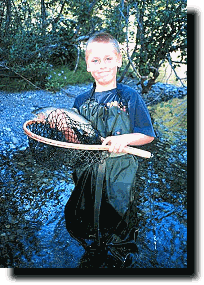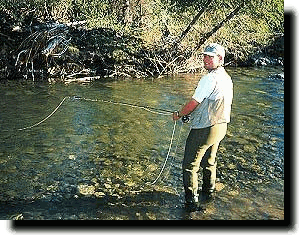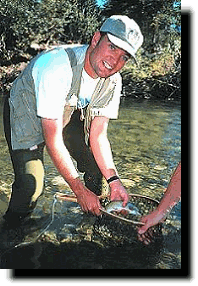Fly-fishing with Novices
Keep it simple
By Clive Schaupmeyer
 Over the years I have tried to help several novice fly anglers. This
summer I went fly-fishing with three beginner fly anglers. All were
making reasonable casts after a couple of hours and they were grinning
at the end of the day. And yes, they all caught one or a few small
cutthroat trout. They were successful and fun trips.
Over the years I have tried to help several novice fly anglers. This
summer I went fly-fishing with three beginner fly anglers. All were
making reasonable casts after a couple of hours and they were grinning
at the end of the day. And yes, they all caught one or a few small
cutthroat trout. They were successful and fun trips.
 Before going further I must clear up something so no one gets confused
about my role and methods as a teacher. I am not a fly fishing or
casting instructor. I'm just a guy who likes to fly fish and each year I
end up taking one or two folks who have never fly-fished before. These
are not Yuppie Gorbies who have $1,000 worth of new gear and taken all
the uptown classes. They are a friend's teenage son, a business
acquaintance, or the fellow who purchased my donated fly- fishing trip
at the church fund-raising auction. These are pretty casual affairs and
likely happen all the time.
Over the years I have learned a few things. And hopefully my guests have
as well. Three years ago I took 12-year-old Mike Day who had never
fly-fished before. This summer he and I fished together again on a
couple of mountain streams. It was so neat. He had his own gear and
looked like he had been casting for years. I was thrilled. Way to go
Mike!
Here are some things I have noticed about novice fly anglers.
The main objective for the first day of fly-fishing is not to catch
fish, but one or two trout strengthen the experience for the novice. So
far, none of my guests have been skunked on their maiden fly-fishing
outing because I take them to places where there is a high probability
that fish will be caught. My preferred places are small cutthroats
streams in southwestern Alberta in August. These are as close to a
guarantee of catching fish that you'll find anywhere.
Before going further I must clear up something so no one gets confused
about my role and methods as a teacher. I am not a fly fishing or
casting instructor. I'm just a guy who likes to fly fish and each year I
end up taking one or two folks who have never fly-fished before. These
are not Yuppie Gorbies who have $1,000 worth of new gear and taken all
the uptown classes. They are a friend's teenage son, a business
acquaintance, or the fellow who purchased my donated fly- fishing trip
at the church fund-raising auction. These are pretty casual affairs and
likely happen all the time.
Over the years I have learned a few things. And hopefully my guests have
as well. Three years ago I took 12-year-old Mike Day who had never
fly-fished before. This summer he and I fished together again on a
couple of mountain streams. It was so neat. He had his own gear and
looked like he had been casting for years. I was thrilled. Way to go
Mike!
Here are some things I have noticed about novice fly anglers.
The main objective for the first day of fly-fishing is not to catch
fish, but one or two trout strengthen the experience for the novice. So
far, none of my guests have been skunked on their maiden fly-fishing
outing because I take them to places where there is a high probability
that fish will be caught. My preferred places are small cutthroats
streams in southwestern Alberta in August. These are as close to a
guarantee of catching fish that you'll find anywhere.

I wrote in my book, "The Essential Guide to Fly-Fishing,"
that it is not possible to learn everything at once. In his book "A brief
History of Time," astrophysicist Stephen Hawking wrote, "Time is what
prevents everything from happening at once." Which we can interpret
to mean that it is not possible to learn everything about fly-fishing in one day.
If you have fly fished for a few years you know that you are still
learning. You learn when you go to stream, pick up a magazine, go to a
club meeting, or when you take a class. It would impossible for our
'students' to learn in a few hours what we have taken all these years to
discover. Our novices can hardly be expected to learn all about tippets,
leaders, casting and insects in one outing. Upon reflection, I think I
expected too much the first two or three times I took beginners out. On
this year's trips I worked solely (okay mainly) on casting. I tied on
flies and explained a bit about leaders and equipment, but the main
objective for the first day on the water was to learn to make a basic
cast. And, of course, to try to correct the three or four common
mistakes made by all beginners.
This may sound too simplistic and you may think I was spoiling the
beginners, but it does seem to work better if the beginner can
concentrate in one thing during the maiden fly-fishing outing. Hopefully
after the first trip their interest is aroused enough to do some
reading. Hopefully they pick up enough information during the first trip
to better understand what they read in the magazines or books.
 I always make sure there are plenty of sandwiches, cold water and juice
in the cooler. Beginners get hungry, thirsty and may actually get
physically tired. It depends on age and perhaps the type of work they do
for a living. Teenagers are perpetually hungry. Older folk not
accustomed to walking along rocky streams may tire more than you'd
expect. These are people who may never have worn waders before, and the
pair they borrowed are not likely the most comfortable. Plan the day
accordingly and take a break now and then.
The one thing we can't ignore while on the first trip is a little
entomology. Connecting fly- fishing to the insects is not only logical,
it is important from an educational point of view. The insects we try to
imitate are the reason we fly-fish in the first place.
I am always thrilled at the amazement shown by novices when we turn over
a rock to find a small mayfly nymph wiggling around. It gets better when
I tell them briefly about the life cycle. Perhaps we'll find an adult
mayfly dun caught up in a backwater, or maybe a few mayflies are
hatching. I explain that a few minutes ago the pretty insects were
'creepy crawlies' like the ones under the rock. I usually have a nymph
or mayfly dry fly in a fly box that looks like the nymph or dun. Mental
gears grind. A look of enlightenment befalls the novice, and you can
imagine them thinking, "Oh! This is why we are here."
This business about the insects and fly fishing is more important than
the details about tippets and knots–all stuff than can be learned at
home anyway. It's so darned important because it's the bugs that make
fly-fishing a reality and I strongly feel it's something that needs to
be pointed out on the stream. (Note that I said "pointed out." We can
hardly go into all the details about bugs. I don't know the details
anyway.)
My approach may sound like a lax way of teaching, but it is not
something I do on a regular basis, nor for a living. If I did, then I
might be more organized or structured in my approach. For now I'll just
keep it simple.
This week's closing thought comes from Henry Rutgers (The founder of the
State University of New Jersey):
Don't let your studies interfere with your education.
As fly-fishers, we might interpret Colonel Henry's idea to mean
something like: Book learning is fine, but a day on the stream teaches
best. ~ Clive Schaupmeyer
Our Man In Canada Archives
I always make sure there are plenty of sandwiches, cold water and juice
in the cooler. Beginners get hungry, thirsty and may actually get
physically tired. It depends on age and perhaps the type of work they do
for a living. Teenagers are perpetually hungry. Older folk not
accustomed to walking along rocky streams may tire more than you'd
expect. These are people who may never have worn waders before, and the
pair they borrowed are not likely the most comfortable. Plan the day
accordingly and take a break now and then.
The one thing we can't ignore while on the first trip is a little
entomology. Connecting fly- fishing to the insects is not only logical,
it is important from an educational point of view. The insects we try to
imitate are the reason we fly-fish in the first place.
I am always thrilled at the amazement shown by novices when we turn over
a rock to find a small mayfly nymph wiggling around. It gets better when
I tell them briefly about the life cycle. Perhaps we'll find an adult
mayfly dun caught up in a backwater, or maybe a few mayflies are
hatching. I explain that a few minutes ago the pretty insects were
'creepy crawlies' like the ones under the rock. I usually have a nymph
or mayfly dry fly in a fly box that looks like the nymph or dun. Mental
gears grind. A look of enlightenment befalls the novice, and you can
imagine them thinking, "Oh! This is why we are here."
This business about the insects and fly fishing is more important than
the details about tippets and knots–all stuff than can be learned at
home anyway. It's so darned important because it's the bugs that make
fly-fishing a reality and I strongly feel it's something that needs to
be pointed out on the stream. (Note that I said "pointed out." We can
hardly go into all the details about bugs. I don't know the details
anyway.)
My approach may sound like a lax way of teaching, but it is not
something I do on a regular basis, nor for a living. If I did, then I
might be more organized or structured in my approach. For now I'll just
keep it simple.
This week's closing thought comes from Henry Rutgers (The founder of the
State University of New Jersey):
Don't let your studies interfere with your education.
As fly-fishers, we might interpret Colonel Henry's idea to mean
something like: Book learning is fine, but a day on the stream teaches
best. ~ Clive Schaupmeyer
Our Man In Canada Archives
Bio on Our Man In Canada

Clive Schaupmeyer is an outdoor writer and
photographer. He is the author of The Essential Guide to
Fly-Fishing, a 288-page book for novice and intermediate fly
anglers. His photo of a boy fishing was judged the best outdoor
picture of 1996 published by a member of the Outdoor Writers
of Canada. He fly-fishes for trout in Alberta's foothill and
mountain streams and for pike near his home in Brooks,
Alberta.
For information on where to find, or how to get a copy of
Clive's book, Click here!
|

 September 28th, 1998
September 28th, 1998



 I always make sure there are plenty of sandwiches, cold water and juice
in the cooler. Beginners get hungry, thirsty and may actually get
physically tired. It depends on age and perhaps the type of work they do
for a living. Teenagers are perpetually hungry. Older folk not
accustomed to walking along rocky streams may tire more than you'd
expect. These are people who may never have worn waders before, and the
pair they borrowed are not likely the most comfortable. Plan the day
accordingly and take a break now and then.
I always make sure there are plenty of sandwiches, cold water and juice
in the cooler. Beginners get hungry, thirsty and may actually get
physically tired. It depends on age and perhaps the type of work they do
for a living. Teenagers are perpetually hungry. Older folk not
accustomed to walking along rocky streams may tire more than you'd
expect. These are people who may never have worn waders before, and the
pair they borrowed are not likely the most comfortable. Plan the day
accordingly and take a break now and then.
